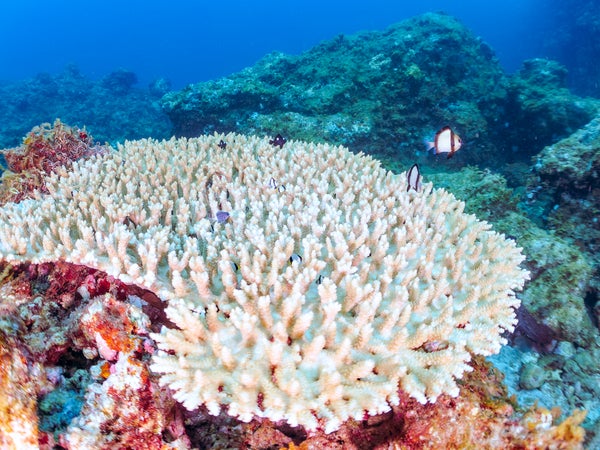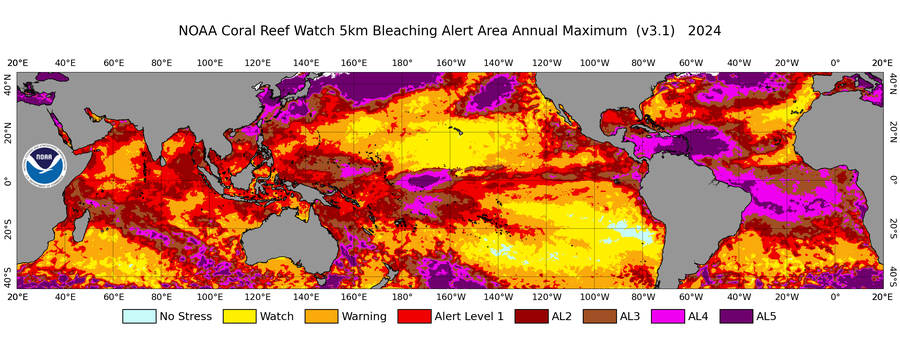84 Percent of Corals Impacted in Mass Bleaching Event
The world is experiencing the most intense global coral bleaching event on record, with 84 percent of reefs experiencing heat stress from warming oceans

Fish swim around a bleached coral.
d3_plus D.Naruse @ Japan/Getty Images
All around the world, from the Great Barrier Reef to the Florida Keys, the bright, vibrant colors of coral reefs have turned ghostly white in vast swaths as our planet has experienced the largest mass coral bleaching event on record. The crisis could have enormous consequences for ocean ecosystems and the global economy.
Some 84 percent of the world’s reefs have been hit by bleaching since January 1, 2023, according to the International Coral Reef Initiative (ICRI), a global partnership among various countries and organizations. This is the fourth global bleaching event since 1998, and it surpasses the record set by the previous one, which lasted from 2014 to 2017 and affected two thirds of the ocean’s reefs.
What is coral bleaching?
On supporting science journalism
If you’re enjoying this article, consider supporting our award-winning journalism by subscribing. By purchasing a subscription you are helping to ensure the future of impactful stories about the discoveries and ideas shaping our world today.
Corals are symbiotic animals: they get their bright colors from algae that live within them. The corals supply the algae with needed nitrogen, and the algae in turn supply the corals with the carbon they use as food. But if the water gets too warm, the algae release toxic compounds, and the corals expel the algae, leaving the corals with clear tissues through which their white skeleton is visible. If temperatures cool again, algae can recolonize the corals, and the reef can heal. But during the time the algae are gone, the corals become weakened and more susceptible to disease and pollution—and if the algae stay away too long, the corals die.
That’s not just a concern for people who enjoy diving to view the teeming reefs; bleaching has potentially huge ecological and economic ramifications. Reefs are extremely biodiverse—they are sometimes called the “rainforests of the sea”—and support about one third of all known marine life. Corals also protect shorelines from erosion and storms. Some research has estimated they contribute about $9.8 trillion to the global economy each year.
During the current bleaching event, “82 countries, territories and economies” have suffered damage as a result, the ICRI says.
What is causing the mass bleaching event?
The event has been driven by persistent, exceptionally hot ocean temperatures, fueled by global warming. The average global temperature is about 2.7 degrees Fahrenheit (1.5 degrees Celsius) higher than it was in the late 19th century, and the bulk of that excess heat has been absorbed by the oceans. The average global ocean surface temperature reached a record-warm level in 2024, according to the U.S. National Oceanic and Atmospheric Administration.

A map showing the maximum extent of coral bleaching in 2024. From blue to dark purple, the colors show increasing threats of bleaching and coral mortality. Light blue indicates no stress to reefs, level 2 (dark red) indicates a risk of mortality to heat-sensitive corals and dark purple indicates a risk of death to 80 percent or more of corals in a reef.
Because of the exceptional heat, NOAA’s Coral Reef Watch program had to add three new levels to the agency’s Bleaching Alert Scale in 2023. Previously, the highest level was 2, which indicated risk of mortality in heat-sensitive corals. Now the highest level means that more than 80 percent of corals on a reef are at risk of dying.
As the planet’s temperatures continue to rise, so does the threat that more reefs may disappear. “We may never see the heat stress that causes bleaching dropping below the threshold that triggers a global event,” said Mark Eakin, corresponding secretary for the International Coral Reef Society and former chief of Coral Reef Watch, to the Associated Press. “We’re looking at something that’s completely changing the face of our planet and the ability of our oceans to sustain lives and livelihoods.”
How can coral reefs be protected?
Many scientists are studying corals to see what types might best withstand marine heat waves. Researchers are also investigating whether coral fragments can be propagated in labs and replanted to restore reefs.
But the most effective ways to protect and preserve reefs is to minimize humans’ effects by curtailing pollution that washes into the ocean from land, ending overfishing and curbing the emission of carbon dioxide and other greenhouse gases.
“The best way to protect coral reefs is to address the root cause of climate change. And that means reducing the human emissions that are mostly from burning of fossil fuels,” Eakin told the Associated Press. “Everything else is looking more like a Band-Aid rather than a solution.”




